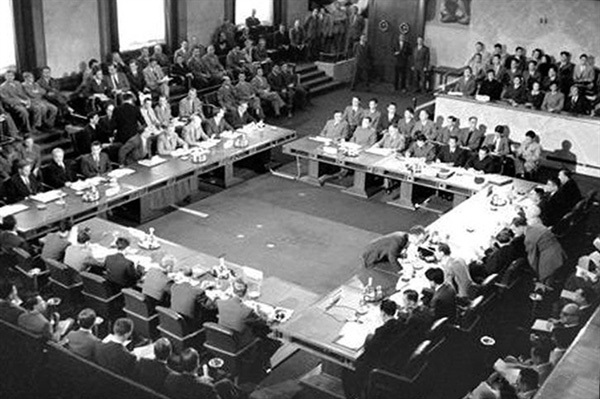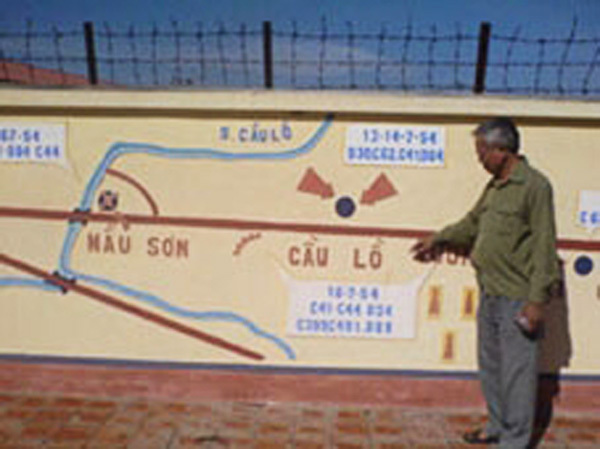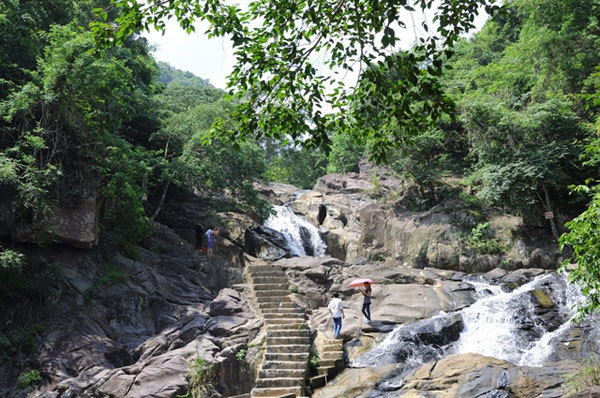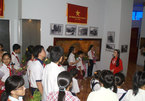on July 14, 1954, nine weeks after Vietnam's victory over France in the prolonged battle at Dien Bien Phu and a week before the Geneva signing.
 |
| HISTORIC: The Geneva Conference in 1954 decided to split Vietnam into two: the North under the administration of the Ho Chi Minh Government, the South under the pro-French, US-supported Saì Gon regime. VNA/VNS Archives |
The officers of the 36th Regiment, 308th Division of the PAVN (People's Army of Vietnam) were famous for devising innovative strategy and for protecting their troops, yet at Cau Lo the PAVN lost one-third of a full-strength regiment—318 soldiers. Most lie in nameless graves.
How could this huge loss have happened?
The answer? Geography, strong French defences, and American heavy weapons.
But that's not all.[1]
The PAVN's Le Hong Phong Campaign four years earlier in the autumn of 1950 precipitated a string of victories on Route 4, the track running along the Vietnamese-Chinese border from Cao Bang in the mountainous far north to the East Sea (sometimes known outside Vietnam and the Philippines as the South China Sea).
Vietnamese control of Route 4 opened the route for arms coming from the Soviet Union and China. It also created a crisis in French morale, precipitated leadership dilemmas in Hanoi and Paris, and shifted American alarm about the Chinese in Korea to include worries that the Chinese would invade the Red River Delta. The French military leaders evacuated their wives and children from Hanoi and the port city of Hai Phong. They briefly considered abandoning the rice-rich Red River Delta.[2]
However, everything changed two months later, on December 17, 1950, with the arrival in Sai Gon of French General de Lattre announcing his unprecedented dual roles of high commissioner for Indochina and commander of the French Far-East Expeditionary Corps. French historian Général Yves Gras described de Lattre as a World War II hero, who projected "an image of grandeur" and whose "attitude proclaimed a total rupture with the shameful past."[3]
On March 17, 1950 de Lattre secured funding for building his "redoubt",[4] which he based on the German Westwall Siegfried Line, also known as the Dragons' Teeth. De Lattre planned to protect the Red River Delta with a line comprising 1,240 bunkers capable of withstanding 155-mm shells. He had completed 700 bunkers when he reported in person to the US State Department in Washington on September 17, 1951.
According to a State Department memo, General de Lattre insisted that "there was mutual agreement that colonialism was a dead issue. … It was his responsibility to stay on the job in Indochina because it was his duty, but it must be remembered that it was the American battlefield as well as the French."[5]
Perhaps to help secure funding during the communist scare, General de Lattre insisted, again according to a State Department memo, that his redoubt was "not for defense against VM [Việt Minh, the PAVN forces] but against possible Chinese invasion",[6] which he predicted to be at least several months away. A year later, President Ho Chi Minh, writing "Behind the Green Bamboo Hedge" on January 10, 1952, repeated a quotation by a "quisling" (bù nhìn) minister of state in L'Observateur (The Observer): "'[de Lattre de] Tassigny has finished his great defensive perimeter, but the Việt Minh troops still cross it at night.'"[7]
The de Lattre Line cordoning off the Red River Delta stretched about 350 kilometres, starting from Tien Yen on the Chinese border west of Mong Cai. It circled around Hai Phong, Hanoi, and Ninh Binh, and then it reached south to the East Sea. The Line enclosed not only the sea port at Hai Phong but also airports, strategic highways, and railroads. Its concrete blockhouses with mutually supportive artillery placements had long sight-lines across the plains to adjacent blockhouses. Roads provided easy access for French tanks and trucks bringing troop reinforcements.
French and American reconnaissance aircraft, supply planes, and bombers stationed at delta airfields were freed from dipping and diving around the mountains that had harboured PAVN anti-aircraft guns in secret bunkers overlooking the French base in the Dien Bien Phu Plain. Further, tight French control of village populations in the Red River Delta had forced local senior revolutionary leaders to work from sites the DRVN (Democratic Republic of Vietnam) held in the mountains.
Cau Lo Post (known to the French as Camp Erulin) was a key link in the de Lattre Line at the juncture between then Routes 13 and 17 in Lan Mau Commune, Luc Nam District, Bac Giang Province. It also protected a French airstrip.
By mid-1954, the post had eight concrete blockhouses, six of which had been renovated, two new bunkers, and four encircling barbed-wire barriers separated by mine fields ten to fifteen metres wide. A French officer and a hundred European and African troops guarded the site with four heavy machine guns, 18 medium machine guns, 20 small machine guns, an 81-mm mortar, three 60-mm mortars, as well as sub-machine guns and rifles.[8]
Pham Hong Cư, a political officer for the 36th Regiment and a brother-in-law to General Vo Nguyen Giap, met the Bac Giang leaders in the mountains and secured a list of activists undercover in the Cau Lo area. Then Hong Cư went undercover and worked in secret with the local leaders to devise a detailed assault plan.
The PAVN troops would rely on local residents for food, supplies, and first aid. Since the 36th Regiment lacked tanks, artillery, and anti-aircraft guns, the soldiers under regimental commander Pham Hong Son, also a brother-in-law to General Giap, protected themselves for their impending assault by digging trenches around the seemingly impenetrable post.[9]
The 36th Regiment did overrun Cau Lo Post and captured sixty-something prisoners and twenty-eight assorted heavy and medium weapons.[10] Yet despite careful planning and trenching, the PAVN attack ended in a disaster, with the loss of 318 troops.
Why?
The answer? Napalm.
Napalm, an American invention, is jellied gasoline, which the United States manufactured and supplied during the French-American War. The name comes from naphthenic and palmitic acids, two of the chemicals used in the manufacturing process that chemists in a secret laboratory at Harvard University had developed during World War II. Whenever napalm canisters strike a target, they explode, sucking up oxygen and engulfing the area in flames and thick, black smoke. The United States used napalm during World War II and the Korean War, supplied it to France during the French-American War, and continued to employ it during the American War (1954‒1975).
President Ho Chi Minh wrote about napalm during the French-American War, citing, "'Made in the USA.' … Material aid [to France] increased markedly from June 1950 after the Americans began to interfere in Korea. The United States provided France with airplanes, warships, transport vehicles, military equipment, and napalm bombs."[11]
Ho Chi Minh mentioned napalm on September 9, 1952 when writing about French Catholics' opposition to the war [12] and wrote again about French Catholics' two specific objections—"every war of invasion" and "use of horrible weapons, such as napalm, etc."[13] That second article appeared on July 9, 1954, less than a week before the Battle of Cau Lo and less than two weeks before the signing of the Geneva Agreement.
 |
| ICONIC: The Pulitzer-winning photo of 'Napalm Girl' by Nick Út, then an Associated Press photographer, touched the hearts of millions people around the world. AP Photo |
The Pentagon Papers, the top-secret study that US Secretary of Defense Robert McNamara commissioned on June 17, 1967 to explore the history of the American War in Vietnam and which The Washington Post and The New York Times bravely published in June 1971, included a memorandum from Admiral Arthur Radford, chair of the US Joint Chiefs-of-Staff, to President Eisenhower on March 24, 1954 regarding C-119s and napalm: "[French] General Ély affirmed the gravity of the situation at Dien Bien Phu stating the outcome as 50-50, and emphasised the great importance of that battle from the political and psychological standpoint. ... He was given approval to use C-119 transport aircraft to drop Napalm provided no U.S. crews were involved."[14]
C-119s could carry nine containers of napalm, each with ninety canisters. This memo reveals official US sanctioning at the highest level of napalm's use, but the memo's date does not reflect the first French use of napalm in Indochina, which was at Vinh Yen in Vietnam's Northern Region [Tonkin] on January 13, 1951, with newly arrived General de Lattre supervising. At that time, before de Lattre's lobbying in Washington during mid-September 1951, the United States covered between 40 per cent and 50 per cent of the French costs of the war.[15]
 |
| REMEMBER: General Phạm Hồng Cư put forward a campaign to build a memorial for the soldiers who died of napalm used by the French troops three days before the signing of the Agreement on Peace in Indochina in Geneva in 1954. Photo courtesy of Nhân Dân newspaper |
In ĐIỆN BIÊN PHỦ: Rendezvous with History, General Vo Nguyen Giap alluded to napalm, writing that the French used B-26 aircraft to drop napalm [16] and that "reconnaissance planes flew ahead to search so that fighter aircraft could drop napalm." [17] He wrote that French soldiers hid cases containing forty litres of napalm in the mountains [18] and noted that PAVN soldiers had dug shelters for protection from napalm. [19] He stated that the French dropped napalm on PAVN supply routes, particularly on Co Noi and Pha Din Passes.[20] He mentioned napalm dropped on PAVN troops digging the trenches that encircled Dien Bien Phu [21] and noted that the French used napalm at Dominique 1 and Dominique 2. [22]
Nevertheless, because of high humidity and rains, the napalm used at Dien Bien Phu did not spread fires as widely or as intensely as the French and their American advisors and funders had anticipated. Bernard Fall provides specifics in his entry for March 23, 1954, the day before Admiral Radford's memorandum to US President Eisenhower about granting French General Ély permission to use C-119 transport aircraft to drop napalm:
"Late in the afternoon the garrison was treated to the French Air Force's Operation 'Neptune'—a massive napalm bombardment of the enemy trench position around Dien Bien Phu. While the sheet of flame and black smoke creeping over the hills were impressive, the application of napalm on a waterlogged rain forest seemed of dubious efficiency. A few minutes after the end of the barrage, ground observers reported that the napalm had burned but had not set spreading fires. The following morning, [French] headquarters at Dien Bien Phu reported laconically that the effect had 'not yielded observable results.' Understandably, the [French] Air Force launched Operation 'Eole' on the stretch of Road 41 leading into the valley of Dien Bien Phu. This effort did not yield observable results, either."[23]
Yet although in his memoir General Giap mentions the battles in Bac Giang Province after the Battle of Dien Bien Phu, he gives no specifics about Cau Lo.
 |
| THINGS CHANGE: Today many people know little about the Cầu Lồ battle in Luc Nam District in Bac Giang Province. The region now boasts lush green lychee orchards and the refreshing Suoi Mo Waterfall. Photo dulichbacgiang.gov.vn |
Now, looking back, the causes of the historical silence shrouding Cau Lo's losses from napalm seem obvious:
The horror of 318 soldiers burnt alive—most beyond recognition in their protective trenches—was unspeakable.
Notification of families of the Cau Lo deceased would have taken months and, as happens with military notifications worldwide, would not have included details about the cause of death.
The seemingly impenetrable blockhouses had protected the French, Europeans, and Africans from the holocaust, while the remaining troops from the 36th Regiment marched five miles to Chi Tac Post, which they captured three days later, on July 17, three days before the Geneva signing.
By the time of the Battle of Cau Lo, the United States was covering nearly 80 per cent of the French costs of the war. American advisors in Hanoi must have known about Cau Lo, but they may not have reported the napalm results upwards.
The Cau Lo Battle coincided with US Secretary of State Dulles' Paris trip, which the secretary had announced on July 12, for a meeting on July 13 and 14 with French Premier Mendès-France and British Foreign Secretary Eden. The PAVN victory came amidst the DRVN's need to project impressive conquests to affect the Geneva Conference, when clarity about the final Agreement (which French Premier Mendès-France had promised would be signed by July 20) had yet to crystalise.[24]
The signing of the Geneva Agreement at midnight Geneva time on July 20, 1954 threw Vietnam into turmoil to forestall the efforts of US Colonel Edward Lansdale's CIA team to undermine the DRVN in North Vietnam and US General Mike O'Daniel's US efforts to replace France as sponsor of the ARVN (Army of the Republic of Vietnam) in South Vietnam.
Historians on all sides may have buried the Battle of Cau Lo, but the tragedy will always haunt the 318 napalm victims' families and the 36th Regiment's surviving veterans. Among those most haunted was Le Binh (? – c. 2016), a 36th Regiment veteran who spent seventeen years to verify the names of the 318 and to secure funding from regimental, local, and national sources for a monument near the four Cau Lo cemeteries. Only 111 of the graves are identified, but the monument lists all 318 who lost their lives.[25]
The napalm holocaust at Cau Lo will always haunt the Vietnamese who come to pray in silence before the Cau Lo Monument, hoping that fragrant smoke from the sticks of incense they light reaches the four cemeteries and soothes the victims' souls.
* Writer's Tag Line: Lady Borton's annotated translation of ĐIỆN BIÊN PHỦ: Rendezvous with History by victorious Vietnamese General Võ Nguyên Giáp is forthcoming from Ohio University Press in Athens, Ohio. This American edition includes new annotations, Vietnamese photographs, maps, a first-time map of General Giáp's base on Mường Phăng Mountain overlooking the French base at Điện Biên Phủ, a chronology, and an exhaustive index.
Endnotes:
[1] Interview with Phạm Hồng Cư, Hà Nội, Việt Nam, August 19, 2019. At the time of the Battle of Cầu Lồ, Phạm Hồng Cư was a political commissar for the 36th Regiment. He retired as a lieutenant general and deputy head of the PAVN Political Department. Now in his nineties, General Hồng Cư (1926‒) is among the few PAVN senior officers from the French-American War who can still describe that war's various battles.
[2] Général Yves Gras, Histoire de la Guerre d'Indochine (History of the Indochina War) (Paris: Plon, 1979), 364-65.
[3] Gras, 367. Translated by the author.
[4] Gras, 398.
[5] "Minutes of the First Meeting with General de Lattre de Tassigny at the Department of State, September 17, 1951, 10:30 a.m.," Document 272, US Department of State, Foreign Relations of the United States, 1951, Asia and the Pacific, Volume VI, Part I, see: https://history.state.gov/historicaldocuments/frus1951v06p1/d272. (This is a very interesting document!) Accessed: September 11, 2019.
[6] "The Minister at Saigon (Heath) to the Secretary of State, secret, Saigon, January 21, 1951—noon," Document 178, Ibid., see: https://history.state.gov/historicaldocuments/frus1951v06p1/d178. Accessed: September 11, 2019.
[7] Hồ Chí Minh (writing as C.B.), "Sau Lũy Tre Xanh" ("Behind the Green Bamboo Hedge"), Nhân Dân (The People, [the Party newspaper]), Number 40, January 10, 1952 in Hồ Chí Minh: Toàn Tập, (Hồ Chí Minh: Collected Works), Volume 7, 1951‒1952 (Hà Nội: NXB Chính Trị Quốc Gia [National Political Publishing House], 2011), 276-77. Translated by the author.
[8] Nguyễn Nam Phương, Về Các Tổng Tư Lệnh, Tư Lệnh Chiến Trường Nhật - Pháp Trong Cuộc Chiến Tranh Xâm Lược Việt Nam (Regarding the General Command and the Japanese – French Command during The[ir] Wars Invading Việt Nam) (Hà Nội, NXB Chính Trị Quốc Gia [National Political Publishing House], 2016), 197-98. Translated by the author.
Nguyễn Nam Phương, Về Các Tổng Tư Lệnh, Tư Lệnh Chiến Trường Nhật - Pháp Trong Cuộc Chiến Tranh Xâm Lược Việt Nam (Hà Nội, NXB Chính Trị Quốc Gia, 2016), 197-98.
[9] Interview with Political Officer Phạm Hồng Cư. Battle Commander Phạm Hồng Sơn (1923‒2013) does not mention the battle in his memoir, Nửa Đời Chiến Trận (Half a Life in Battle), which covers the French-American War and has been published as the first half of Nhớ và Quên (Remembering and Forgetting. See: Phạm Hồng Sơn and Đặng Anh Đào, Nhớ và Quên (Remembering and Forgetting) (Hà Nội, NXB Phụ Nữ [Women's Publishing House], 2011). Phạn Hồng Sơn's wife, Đặng Anh Đào, compiled the second half about the American War (1954‒1975) from Phạm Hồng Sơn's letters and documents as he was descending into Alzheimer's Disease. By the time of publication, Phạm Hồng Sơn could sign his name on books but could no longer recognise acquaintances.
[10] "Trận Cầu Lồ (Cầu Lồ Battle), Dựng Nước, Giữ Nươc (Establish the Country, Protect the Country), https://www.quansuvn.net/index.php?topic=31575.180. Accessed: September 11, 2019.
[11] Hồ Chí Minh, writing as DIN, "Bọn Đế Quốc Cướp Nước Không Bao Giờ Có Thể Nô Dịch Dân Tộc Việt Nam Anh Dũng" (The Imperialists Seizing the Country Can Never Enslave the Heroic Vietnamese People), Hồ Chí Minh: Toàn Tập (Hồ Chí Minh: Collected Works), Volume 7, 1951‒1952 (Hà Nội: NXB Chính Trị Quốc Gia [National Political Publishing House], 2011), 301. Translated by the author.
[12] Hồ Chí Minh, writing as C.B., "Công Giáo Pháp Chống Chiến Tranh Xâm Lược Ở Việt Nam" (French Catholics Oppose the French War of Invasion in Việt Nam), Nhân Dân (The People, [the Party newspaper]), Number 73, September 11, 1952, Ibid., 491.
[13] Hồ Chí Minh, writing as C.B., "Công Giáo Pháp Chống Chiến Tranh Xâm Lược Việt Nam," (French Catholics Oppose the War of Invasion in Việt Nam), Nhân Dân (The People, [the Party newspaper]), Number 202, July 7-9, 1954, Hồ Chí Minh: Toàn Tập (Hồ Chí Minh: Collected Works), Volume 8, 1953‒1954 (Hà Nội: NXB Chính Trị Quốc Gia [National Political Publishing House], 2011), 541. Translated by the author.
[14] Arthur Radford, "Memorandum for the President", March 24, 1954, The Pentagon Papers, Part 5-B-3b, 288-90. For scans of the actual files, see: https://nara-media-001.s3.amazonaws.com/arcmedia/research/pentagon-papers/Pentagon-Papers-Part-V-B-3b.pdf. Accessed: September 11, 2019.
[15] Maurice de Poitevin, La Guerre d'Indochine (The Indochina War), Chapter 8, see: http://www.lauragais-patrimoine.fr/HISTOIRE/INDOCHINE/SOMMAIRE.html. Accessed: September 11, 2019.
[16] Võ Nguyên Giáp, ĐIỆN BIÊN PHỦ: Rendezvous with History, translated by Lady Borton (Hà Nội: NXB Thế Giới [World Publishers] 2017, forthcoming from Ohio University Press),
[17] Giáp, ĐIỆN BIÊN PHỦ: Điểm hẹn lịch sử
[18] Giáp, ĐIỆN BIÊN PHỦ: Điểm hẹn lịch sử
[19] Giáp, ĐIỆN BIÊN PHỦ: Điểm hẹn lịch sử
[20] Giáp, ĐIỆN BIÊN PHỦ: Điểm hẹn lịch sử
[21] Giáp, ĐIỆN BIÊN PHỦ: Điểm hẹn lịch sử
[22] Giáp, 406. ĐIỆN BIÊN PHỦ: Điểm hẹn lịch sử
[23] Bernard B. Fall, HELL IN A VERY SMALL PLACE: The Siege of Dien Bien Phu (Philadelphia, New York: J. B. Lippincott Company, 1966), 176.
[24] For US Department of State documents about the Geneva Conference on Indochina, July 12-21, 1954, Documents 894-1035, see: Foreign Relations of the United States, 1952–1954, The Geneva Conference, Volume XVI: https://history.state.gov/historicaldocuments/frus1952-54v16/ch7subch66. That link is for July 12. Click on the right-hand arrow for subsequent documents. Accessed: September 11, 2019.
[25] Phạm Hồng Cư, "Tri Ân 318 Liệt Sĩ Của Trung Đoàn".
Lady Borton*

Attempts to preserve keepsakes from resistance wars
Vietnam’s history of resistance wars against French colonialism and American imperialism has given it many heroes and magnanimous stories.
Dien Bien Phu victory to be re-enacted through circus art
The Vietnam Circus Federation will host a circus show re-enacting the Dien Bien Phu battlefield in Hanoi on May 5 to celebrate the 65th anniversary of the victory.
 No one knew the Geneva Agreement's signing ending Vietnam's French-American War (1945‒1954) was imminent. This included the Vietnamese, French, Europeans, and Africans who fought at Cau Lo in northern Vietnam's Red River Delta
No one knew the Geneva Agreement's signing ending Vietnam's French-American War (1945‒1954) was imminent. This included the Vietnamese, French, Europeans, and Africans who fought at Cau Lo in northern Vietnam's Red River Delta